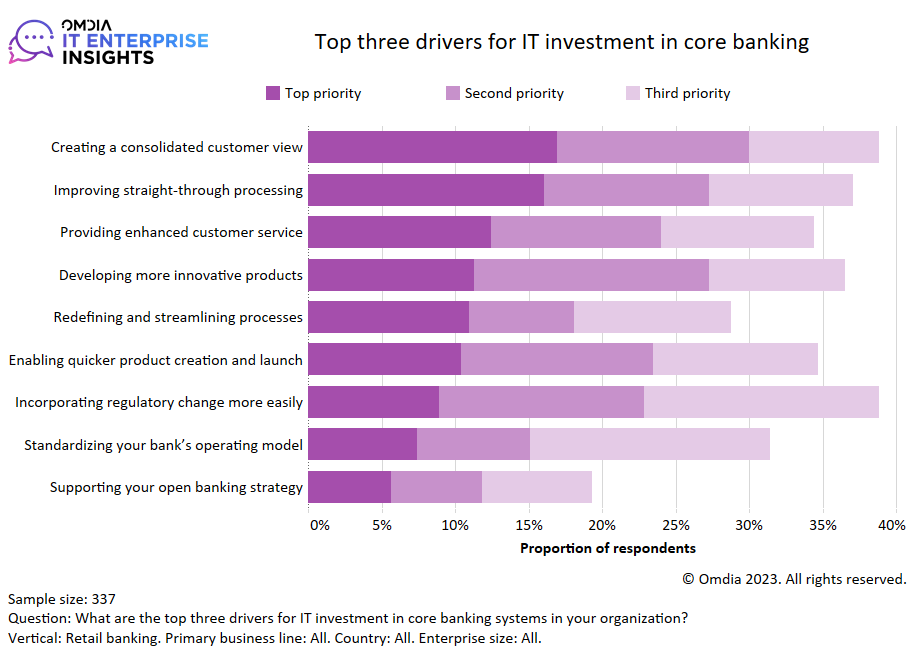State of play: core banking
Each month, Philip Benton, Principal Fintech Analyst at Omdia, explores a new topic and assesses the “state of play”, providing an analysis and understanding of the market landscape.
This month, Philip takes an in-depth look at core banking.
Last month’s column reviewed the state of banking and the macro trends that banks are facing that are threatening their existing business model.
To successfully respond to these trends, banks require an agile and nimble core banking system, which is the focus of this month’s analysis.
Defining the ‘core’ of the bank
I’m stepping on the toes of fellow FinTech Futures columnist Dharmesh Mistry here, who covers core banking in detail for his column and podcast.
To define core banking, Dharmesh uses Acronym Finder’s definition of “centralised online real-time exchange” and explains core banking technology as “Software that manages accounts – be that your current account, deposit or loans. Each time money is taken out, core banking debits your account, and when money is put in, a credit is applied.”
I would go one step further and add that core banking is a backend system that financial institutions use to fully manage customers’ operations by centralising all required components and is the fundamental system of record for customer information.
Core banking systems are often described as the ‘single source of truth’ for banks, but the problem is that banks have ended up, over time, with multiple core systems across their product lines (deposits, loans, mortgages and so on), and there is no longer a ‘single’ source of truth.
Legacy core banking systems are no longer fit for purpose
Many banks have been reluctant to modernise their core banking infrastructure because of complexity, cost and risk. When they’ve had to comply with new regulatory changes or support some enhancement of their existing services, they have usually just updated and patched their existing system, making sacrifices, taking shortcuts or using workarounds to meet delivery deadlines and budget constraints.
These sacrifices eventually mount up and cause a technical debt within their core banking infrastructure, hampering their ability not only to innovate and respond to dynamic market requirements, but also to efficiently deliver services and accommodate volume increases because of their aging technology.
According to Omdia’s Retail Banking Survey, more than 64% of banks’ global technology budget is spent on maintaining existing legacy technology and just 36% is allocated to either growing or transforming their technology. In the same survey, banks indicated they are most worried about ‘customer management’, with 45% listing it as one of their top three business concerns.
However, there is a desire among banks to invest in core banking infrastructure, with 38% of respondents indicating that the leading factor in their decision to upgrade their core banking system is to ‘create a consolidated customer view’. This is highlighted in the chart below.

Cloud infrastructure is a big factor in banks recognising the urgent need to upgrade
The shift to cloud-based applications across financial services has been swift, especially in core banking. These upgraded core systems have seen a number of new cloud-native digital banks emerge. This has forced incumbent banks to accelerate plans to upgrade their core banking systems. According to Omdia’s Banking Software Contract Analytics (BSCA), core banking was the most common primary system selected for upgrade during 2023, accounting for 187 deals, representing 28% of overall banking contract activity.
The first generation of core banking systems was generally only used by incumbent financial institutions with complex needs, whereas today, core banking systems need to cater to both the simpler needs of neobanks and the more complex requirements of larger institutions.
Over the past five years, we have seen a new generation of core banking systems emerge, which have been built leveraging cloud-native functionality, open-source languages and modern coding standards to enable continuous integration and continuous deployment and, ultimately, accelerate the ease and speed of bringing new products to the market.
The architecture of these platforms is microservices-led and event-driven to enable financial institutions to embrace a new world of composable banking. Composable banking is about giving the bank the freedom to deploy modules independently, without vendor lock-in, and easily integrate multiple external systems driven through APIs.
‘Big bang’ migrations are no longer the norm, lowering market entry for new vendors
Last year, Omdia published a comprehensive report that evaluates both the new and legacy vendors that provide cloud-based core banking platforms. Our research findings show that the “big bang” approach of migrating completely to a new platform is no longer the norm, with many banks opting to adopt a phased “side car” migration by moving specific products or locations. This latter approach can take longer, requiring ongoing testing and rollout of new capabilities, but is considered less risky.
Some of the newer vendors to enter the cloud-based core banking market (Thought Machine, 10x, Pismo and so on) have taken the approach of enabling composable banking through a “thin core”, whereby they provide a narrower set of functionalities but make it easier to integrate broader capabilities through a wider partner ecosystem of niche solution providers.
This approach is viable as long as the vendor is able to provide a “golden” source of truth whereby data is easily shareable across the banking group, and the core banking solution can provide real-time transaction processing, settlement and performance at scale.
The vendor landscape is constantly evolving, with providers aiming to strengthen their position through M&A activity, fundraising or partnerships to capitalise on the expected growth in demand for modern core banking platforms. Fiserv acquired Finxact in 2022 in order to accelerate the modernisation efforts of its clients and prospects and appeal to a broader client base. In January 2024, Visa completed its acquisition of Pismo, which will expand the vendor’s global footprint.
A growing number of banks are also investing in core banking vendors as they look to shape the overall direction of core banking software and innovation. Some banks have even spun out their core banking technology as a new division to sell to other banks, including Engine by Starling and XYB by Monese.
Core banking requires continual upgrades with SaaS increasingly in demand
Demanding customer expectations, growing competition from fintechs and increasing regulatory pressures (stemming from areas such as data privacy and open banking) will continue to play a part in the transformation of financial services. Despite macroeconomic uncertainty and cost-cutting pressures, investment in technology will continue to be the utmost priority for the industry, with banks looking to increase their IT spending with a focus on core banking systems.
As such, the industry is now shifting to Software-as-a-Service (SaaS) and cloud-native models, which can facilitate innovation while simultaneously removing obstacles to integration with the wider fintech ecosystem.
Many banks remain wary of embarking on transforming their core banking system due to fear of the significant time and investment required before generating a return. However, many vendors look to overcome this obstacle by supporting a “side car” approach, thereby enabling the new core to run parallel to the existing core by migrating certain products, locations, customers or lines of business.
However, every bank’s needs are different, and so a one-size-fits-all approach will not be suitable for all. Banks should assess their existing capabilities, customer needs and operational risk and, in relation to market trends, select the vendor and platform most relevant to their business and technical goals.
For all financial institutions, one of the biggest challenges is keeping pace with constant change. To capitalise on new opportunities and be ready for the unexpected, banks need to have systems in place to support a flexible and agile approach to product development that allows for speed-to-market, with core banking being ‘core’ to it all.
About the author
 Philip Benton is a Principal Fintech Analyst at Omdia and writes analysis on the issues driving technological change in financial services. Prior to Omdia, he led consumer trends research in retail and payments at strategic market research firm Euromonitor.
Philip Benton is a Principal Fintech Analyst at Omdia and writes analysis on the issues driving technological change in financial services. Prior to Omdia, he led consumer trends research in retail and payments at strategic market research firm Euromonitor.
In this column, Philip will discuss the technological implications and consumer expectations of the latest fintech trends.
You can find more of Philip’s views on fintech via LinkedIn or follow him on X @bentonfintech.











































